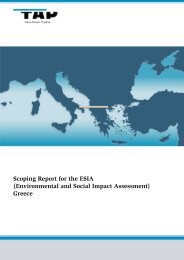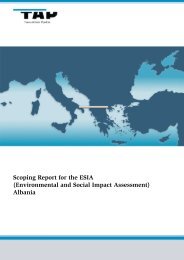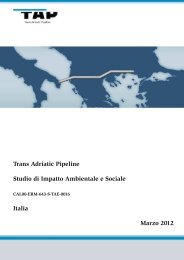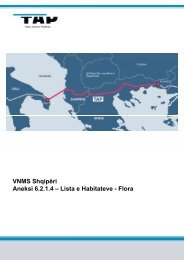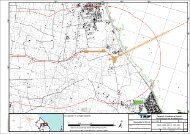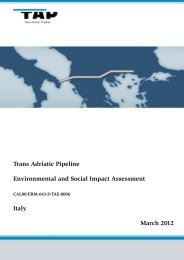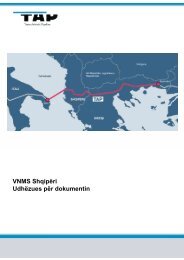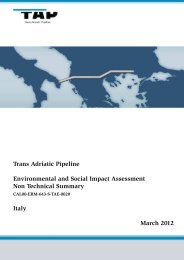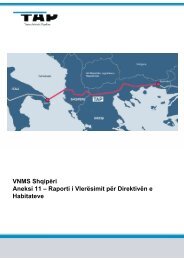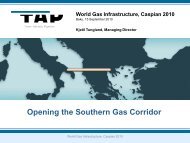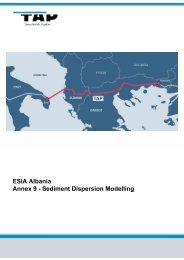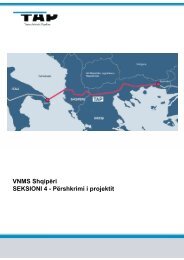ESIA Italy â Annex 3 Main Legislation on Energy and Gas Sector
ESIA Italy â Annex 3 Main Legislation on Energy and Gas Sector
ESIA Italy â Annex 3 Main Legislation on Energy and Gas Sector
Create successful ePaper yourself
Turn your PDF publications into a flip-book with our unique Google optimized e-Paper software.
Page 1 of 29<br />
Area<br />
Code<br />
Comp.<br />
Code<br />
System<br />
Code<br />
Disc.<br />
Code<br />
Doc.-<br />
Type<br />
Ser.<br />
No.<br />
Ordering Unit:<br />
Owner:<br />
Project Title:<br />
Trans Adriatic Pipeline AG<br />
Envir<strong>on</strong>mental Resources Management<br />
Trans Adriatic Pipeline – TAP<br />
CAL00-ERM-643-S-TAE-0012<br />
Rev: 00<br />
Document Title:<br />
<str<strong>on</strong>g>ESIA</str<strong>on</strong>g> <str<strong>on</strong>g>Italy</str<strong>on</strong>g> – <str<strong>on</strong>g>Annex</str<strong>on</strong>g> 3<br />
<str<strong>on</strong>g>Main</str<strong>on</strong>g> <str<strong>on</strong>g>Legislati<strong>on</strong></str<strong>on</strong>g> <strong>on</strong> <strong>Energy</strong> <strong>and</strong> <strong>Gas</strong> <strong>Sector</strong><br />
Rev. Purpose of Issue Remark/Descripti<strong>on</strong> Orig. Date<br />
00 Issued for Implementati<strong>on</strong> BEL 2012-03-13<br />
CONTRACTOR<br />
Originator Checked Approved<br />
COMPANY<br />
Name/Signature<br />
Bertolè,<br />
Lorenzo<br />
Strøm,<br />
Øyvind<br />
Falkeid,<br />
Svein Erik Accepted <strong>on</strong> Accepted <strong>on</strong><br />
Date 2012-03-13 2012-03-13 2012-03-13 2012-03-09 2012-03-09<br />
Org. / Dept. ERM STATOIL STATOIL<br />
Document Status Preliminary Checked Approved<br />
Accepted<br />
(Commercial)<br />
Accepted<br />
(Technical)
Project Title:<br />
Document Title:<br />
Trans Adriatic Pipeline – TAP<br />
<str<strong>on</strong>g>ESIA</str<strong>on</strong>g> <str<strong>on</strong>g>Italy</str<strong>on</strong>g> – <str<strong>on</strong>g>Annex</str<strong>on</strong>g> 3 <str<strong>on</strong>g>Main</str<strong>on</strong>g> <str<strong>on</strong>g>Legislati<strong>on</strong></str<strong>on</strong>g> <strong>on</strong> <strong>Energy</strong> <strong>and</strong><br />
<strong>Gas</strong> <strong>Sector</strong><br />
Area<br />
Code<br />
Comp.<br />
Code<br />
Page 2 of 29<br />
System<br />
Code<br />
Disc.<br />
Code<br />
Doc.-<br />
Type<br />
CAL00-ERM-643-S-TAE-0012<br />
Rev: 00<br />
Ser.<br />
No.<br />
TABLE OF CONTENTS<br />
1 INTRODUCTION 4<br />
2 MAIN LEGISLATION ON ENERGY AND GAS SECTOR 5<br />
2.1 Nati<strong>on</strong>al Level 5<br />
2.1.1 Nati<strong>on</strong>al <strong>Energy</strong> Plan 5<br />
2.1.2 Nati<strong>on</strong>al C<strong>on</strong>ference <strong>on</strong> <strong>Energy</strong> <strong>and</strong> Envir<strong>on</strong>ment 8<br />
2.1.3 Carb<strong>on</strong> Tax 8<br />
2.1.4 Legislative Decree n.164/200 9<br />
2.1.5 Law 443/2001 10<br />
2.1.6 Law n.273/2002 11<br />
2.1.7 Law n.239/2004 11<br />
2.1.8 Law n.62/2005 13<br />
2.1.9 Law n.125/2007 13<br />
2.1.10 Strategic Nati<strong>on</strong>al Plan 2007-2013 15<br />
2.1.11 Ec<strong>on</strong>omic <strong>and</strong> Financial Planning Document (DPEF) 2008-2011 16<br />
2.2 Local <strong>and</strong> Regi<strong>on</strong>al Level 16<br />
2.2.1 Apulia Regi<strong>on</strong> <strong>Energy</strong> Envir<strong>on</strong>mental Plan (PEAR) 16<br />
2.2.2 Provincial <strong>Energy</strong> Envir<strong>on</strong>mental Plan (PEAP) 17<br />
3 NATURAL GAS MARKET 19<br />
3.1 European Natural <strong>Gas</strong> Market 19<br />
3.1.1 Current Situati<strong>on</strong> 19<br />
3.1.2 Forecast of Natural <strong>Gas</strong> Dem<strong>and</strong> 20<br />
3.2 Italian Natural <strong>Gas</strong> Market 23<br />
3.2.1 Current Situati<strong>on</strong> 23<br />
3.2.2 Italian Natural <strong>Gas</strong> Infrastructures 27
Project Title:<br />
Document Title:<br />
Trans Adriatic Pipeline – TAP<br />
<str<strong>on</strong>g>ESIA</str<strong>on</strong>g> <str<strong>on</strong>g>Italy</str<strong>on</strong>g> – <str<strong>on</strong>g>Annex</str<strong>on</strong>g> 3 <str<strong>on</strong>g>Main</str<strong>on</strong>g> <str<strong>on</strong>g>Legislati<strong>on</strong></str<strong>on</strong>g> <strong>on</strong> <strong>Energy</strong> <strong>and</strong><br />
<strong>Gas</strong> <strong>Sector</strong><br />
Area<br />
Code<br />
Comp.<br />
Code<br />
Page 3 of 29<br />
System<br />
Code<br />
Disc.<br />
Code<br />
Doc.-<br />
Type<br />
CAL00-ERM-643-S-TAE-0012<br />
Rev: 00<br />
Ser.<br />
No.<br />
CAL00-ERM-643-S-TAE-0001 – Secti<strong>on</strong> 1 Introducti<strong>on</strong><br />
CAL00-ERM-643-S-TAE-0002 – Secti<strong>on</strong> 2 Project Justificati<strong>on</strong><br />
CAL00-ERM-643-S-TAE-0003 – Secti<strong>on</strong> 3 Legal Framework<br />
CAL00-ERM-643-S-TAE-0004 – Secti<strong>on</strong> 4 Project Descripti<strong>on</strong><br />
CAL00-ERM-643-S-TAE-0005 – Secti<strong>on</strong> 5 <str<strong>on</strong>g>ESIA</str<strong>on</strong>g> Approach <strong>and</strong> Methodology<br />
CAL00-ERM-643-S-TAE-0006 – Secti<strong>on</strong> 6 Envir<strong>on</strong>mental, Social <strong>and</strong> Cultural Baseline<br />
CAL00-ERM-643-S-TAE-0007 – Secti<strong>on</strong> 7 Stakeholder Engagement <strong>and</strong> Project Resp<strong>on</strong>se<br />
CAL00-ERM-643-S-TAE-0008 – Secti<strong>on</strong> 8 Assessment of Impacts <strong>and</strong> Mitigati<strong>on</strong> Measures<br />
CAL00-ERM-643-S-TAE-0009 – Secti<strong>on</strong> 9 Envir<strong>on</strong>mental & Social Management <strong>and</strong> M<strong>on</strong>itoring<br />
CAL00-ERM-643-S-TAE-0010 – <str<strong>on</strong>g>Annex</str<strong>on</strong>g> 1 Scoping Advice from MoE<br />
CAL00-ERM-643-S-TAE-0011 – <str<strong>on</strong>g>Annex</str<strong>on</strong>g> 2 Labour, Health <strong>and</strong> Safety <str<strong>on</strong>g>Legislati<strong>on</strong></str<strong>on</strong>g> in <str<strong>on</strong>g>Italy</str<strong>on</strong>g><br />
CAL00-ERM-643-S-TAE-0012 – <str<strong>on</strong>g>Annex</str<strong>on</strong>g> 3 <str<strong>on</strong>g>Main</str<strong>on</strong>g> <str<strong>on</strong>g>Legislati<strong>on</strong></str<strong>on</strong>g> <strong>on</strong> <strong>Energy</strong> <strong>and</strong> <strong>Gas</strong> <strong>Sector</strong><br />
CAL00-ERM-643-S-TAE-0013 – <str<strong>on</strong>g>Annex</str<strong>on</strong>g> 4 Soil Management Plan<br />
CAL00-ERM-643-S-TAE-0014 – <str<strong>on</strong>g>Annex</str<strong>on</strong>g> 5 Baseline Data <strong>and</strong> Maps<br />
CAL00-ERM-643-S-TAE-0015 – <str<strong>on</strong>g>Annex</str<strong>on</strong>g> 6 <str<strong>on</strong>g>ESIA</str<strong>on</strong>g> Baseline <strong>and</strong> Impact Assessment Methodology<br />
CAL00-ERM-643-S-TAE-0016 – <str<strong>on</strong>g>Annex</str<strong>on</strong>g> 7 L<strong>and</strong>scape Impact Assessment<br />
CAL00-ERM-643-S-TAE-0017 – <str<strong>on</strong>g>Annex</str<strong>on</strong>g> 8 Appropriate Assessment <strong>on</strong> Natura 2000 Sites<br />
CAL00-ERM-643-S-TAE-0018 – <str<strong>on</strong>g>Annex</str<strong>on</strong>g> 9 Summary of Impacts <strong>and</strong> Mitigati<strong>on</strong> Measures<br />
CAL00-ERM-643-S-TAE-0019 – <str<strong>on</strong>g>Annex</str<strong>on</strong>g> 10 References, Acr<strong>on</strong>yms <strong>and</strong> Abbreviati<strong>on</strong>s
Project Title:<br />
Document Title:<br />
Trans Adriatic Pipeline – TAP<br />
<str<strong>on</strong>g>ESIA</str<strong>on</strong>g> <str<strong>on</strong>g>Italy</str<strong>on</strong>g> – <str<strong>on</strong>g>Annex</str<strong>on</strong>g> 3 <str<strong>on</strong>g>Main</str<strong>on</strong>g> <str<strong>on</strong>g>Legislati<strong>on</strong></str<strong>on</strong>g> <strong>on</strong> <strong>Energy</strong> <strong>and</strong><br />
<strong>Gas</strong> <strong>Sector</strong><br />
Area<br />
Code<br />
Comp.<br />
Code<br />
Page 4 of 29<br />
System<br />
Code<br />
Disc.<br />
Code<br />
Doc.-<br />
Type<br />
CAL00-ERM-643-S-TAE-0012<br />
Rev: 00<br />
Ser.<br />
No.<br />
1 INTRODUCTION<br />
As <strong>on</strong>e of the world's largest importers of oil, gas <strong>and</strong> coal, the European Uni<strong>on</strong> is a major player<br />
<strong>on</strong> the internati<strong>on</strong>al energy market. Oil remains the most used energy source in the EU while<br />
natural gas is the sec<strong>on</strong>d most used energy.<br />
Regarding natural gas supply, Europe currently relies <strong>on</strong> Russia, Africa <strong>and</strong> the North Sea<br />
through several existing pipelines. Russia is Europe’s key provider. However, Europe realises the<br />
strategic need to diversify its gas supply <strong>and</strong> has taken several steps in this directi<strong>on</strong> (European<br />
Dialogue, 2011).<br />
The Trans Adriatic Pipeline (TAP) is a proposed natural gas pipeline in the so-called Southern<br />
<strong>Gas</strong> Corridor that will bring gas from new reserves in the Caspian regi<strong>on</strong> to Southern <strong>and</strong> Central<br />
Europe. The term is used by the European Commissi<strong>on</strong> to describe planned infrastructure<br />
projects bringing gas from the Caspian <strong>and</strong> Middle Eastern sources to Europe, aimed at<br />
improving security of supply. The TAP Project offers a realistic opportunity in the form of an<br />
alternative transportati<strong>on</strong> route which will open the Southern <strong>Gas</strong> Corridor. It will be the shortest<br />
gas transit route of all the European pipeline projects currently being supported by the EU within<br />
the Southern Corridor.<br />
The TAP will c<strong>on</strong>tribute to the security <strong>and</strong> diversificati<strong>on</strong> of Europe’s energy supply by providing<br />
the necessary infrastructure to transport gas from the Shah Deniz II field in Azerbaijan via the<br />
most direct route to Southern Europe when producti<strong>on</strong> begins in early 2018. As more gas<br />
becomes available, the TAP will have the capacity to cater for an additi<strong>on</strong>al 10 Billi<strong>on</strong> Cubic<br />
Meters (BCM) per annum of new gas, exp<strong>and</strong>ing to 20 BCM as required.
Project Title:<br />
Document Title:<br />
Trans Adriatic Pipeline – TAP<br />
<str<strong>on</strong>g>ESIA</str<strong>on</strong>g> <str<strong>on</strong>g>Italy</str<strong>on</strong>g> – <str<strong>on</strong>g>Annex</str<strong>on</strong>g> 3 <str<strong>on</strong>g>Main</str<strong>on</strong>g> <str<strong>on</strong>g>Legislati<strong>on</strong></str<strong>on</strong>g> <strong>on</strong> <strong>Energy</strong> <strong>and</strong><br />
<strong>Gas</strong> <strong>Sector</strong><br />
Area<br />
Code<br />
Comp.<br />
Code<br />
Page 5 of 29<br />
System<br />
Code<br />
Disc.<br />
Code<br />
Doc.-<br />
Type<br />
CAL00-ERM-643-S-TAE-0012<br />
Rev: 00<br />
Ser.<br />
No.<br />
2 MAIN LEGISLATION ON ENERGY AND GAS SECTOR<br />
2.1 Nati<strong>on</strong>al Level<br />
The regulatory <strong>and</strong> planning instruments at the Nati<strong>on</strong>al level relevant to the proposed project are<br />
as follows:<br />
• Nati<strong>on</strong>al <strong>Energy</strong> Plan approved by the Council of Ministries <strong>on</strong> 10 August 1988;<br />
• Nati<strong>on</strong>al C<strong>on</strong>ference <strong>on</strong> <strong>Energy</strong> <strong>and</strong> Envir<strong>on</strong>ment of 1998;<br />
• Carb<strong>on</strong> Tax introduced as per Art. 8 of Law n. 448 of 23 December 1998;<br />
• Legislative Decree 164 of 23 May 2000, implementing Directive 98/30/CE <strong>on</strong> the liberalizati<strong>on</strong><br />
of the internal gas market;<br />
• Law n. 443 of 21 December 2001, <strong>on</strong> the procedures for assessment <strong>and</strong> approval of<br />
infrastructure <strong>and</strong> producti<strong>on</strong> projects <strong>and</strong> relevant Deliberati<strong>on</strong> of CIPE n. 121 of 21<br />
December 2001;<br />
• Law n. 273 of 12 December 2001, <strong>on</strong> the measures to encourage private initiative <strong>and</strong> the<br />
development of competiti<strong>on</strong>;<br />
• Law n. 239 dated 23 August 2004, <strong>on</strong> reorganisati<strong>on</strong> of the energy sector <strong>and</strong> delegati<strong>on</strong> to<br />
the government for the rehabilitati<strong>on</strong> of the enforced energy regulati<strong>on</strong>;<br />
• Law n. 62 dated 18 April 2005, <strong>on</strong> Italian obligati<strong>on</strong> deriving from European Uni<strong>on</strong><br />
membership, with particular reference to the nati<strong>on</strong>al energy policy;<br />
• Law n. 125 dated 3 August 2007, <strong>on</strong> the measures to liberalize the gas market;<br />
• Nati<strong>on</strong>al Strategic Framework 2007-2013;<br />
• The Ec<strong>on</strong>omic <strong>and</strong> Financial Planning Document (DPEF) 2008-2011.<br />
Based <strong>on</strong> that analyzed <strong>and</strong> described in the following Secti<strong>on</strong>s, the planned project is fully<br />
c<strong>on</strong>sistent with the applicable regulati<strong>on</strong> in force as it would c<strong>on</strong>tribute to diversify the supply<br />
sources of natural gas, increasing security <strong>and</strong> competitiveness.<br />
2.1.1 Nati<strong>on</strong>al <strong>Energy</strong> Plan<br />
The Nati<strong>on</strong>al <strong>Energy</strong> Plan (PEN), approved by the Council of Ministries <strong>on</strong> 10 August 1988, in<br />
order to promote a nati<strong>on</strong>al plan for the rati<strong>on</strong>al use of energy <strong>and</strong> energy saving sets l<strong>on</strong>g term<br />
strategic objectives:
Project Title:<br />
Document Title:<br />
Trans Adriatic Pipeline – TAP<br />
<str<strong>on</strong>g>ESIA</str<strong>on</strong>g> <str<strong>on</strong>g>Italy</str<strong>on</strong>g> – <str<strong>on</strong>g>Annex</str<strong>on</strong>g> 3 <str<strong>on</strong>g>Main</str<strong>on</strong>g> <str<strong>on</strong>g>Legislati<strong>on</strong></str<strong>on</strong>g> <strong>on</strong> <strong>Energy</strong> <strong>and</strong><br />
<strong>Gas</strong> <strong>Sector</strong><br />
Area<br />
Code<br />
Comp.<br />
Code<br />
Page 6 of 29<br />
System<br />
Code<br />
Disc.<br />
Code<br />
Doc.-<br />
Type<br />
CAL00-ERM-643-S-TAE-0012<br />
Rev: 00<br />
Ser.<br />
No.<br />
• <strong>Energy</strong> savings, as a measures system able to improve producti<strong>on</strong> processes <strong>and</strong> to replace<br />
certain products with similar <strong>on</strong>es, but characterized by lower c<strong>on</strong>sumpti<strong>on</strong>, <strong>and</strong> to ensure the<br />
rati<strong>on</strong>alizati<strong>on</strong> of end-uses;<br />
• Envir<strong>on</strong>mental protecti<strong>on</strong> through the development of renewable energy <strong>and</strong> the reducti<strong>on</strong> the<br />
territorial impacts <strong>and</strong> pollutant emissi<strong>on</strong>s resulting from energy producti<strong>on</strong>, processing <strong>and</strong><br />
utilizati<strong>on</strong>.<br />
Although the PEN is a document dated now <strong>and</strong> waiting to be upgraded, especially c<strong>on</strong>sidering<br />
the great changes in the instituti<strong>on</strong>al framework <strong>and</strong> in the Italian market ec<strong>on</strong>omy, partly due to<br />
the increasing importance <strong>and</strong> influence of a European comm<strong>on</strong> energy policy, its objectives <strong>and</strong><br />
l<strong>on</strong>g-term energy priorities remain valid.<br />
In particular, the Nati<strong>on</strong>al <strong>Energy</strong> Plan addresses <strong>and</strong> promotes the following:<br />
• Competitiveness of the producti<strong>on</strong> system <strong>and</strong> the development of nati<strong>on</strong>al resources;<br />
• Reducti<strong>on</strong> of dependence <strong>on</strong> foreign countries;<br />
• Geographic <strong>and</strong> political diversificati<strong>on</strong> of supply areas;<br />
• Rati<strong>on</strong>al use of energy;<br />
• Protecti<strong>on</strong> of the envir<strong>on</strong>ment <strong>and</strong> of human health;<br />
• <strong>Energy</strong> saving.<br />
Regarding the natural gas sector, <strong>on</strong>e of the strategic objectives of PEN is "to diversify the use of<br />
various imports sources <strong>and</strong> the geographic <strong>and</strong> political supply areas.... ".<br />
Once the c<strong>on</strong>tents of the Plan have been established, subsequent Implementing Law n. 9/1991<br />
<strong>and</strong> Law n. 10/1991, relating to the partial liberalizati<strong>on</strong> of electricity producti<strong>on</strong> <strong>and</strong> the promoti<strong>on</strong><br />
of energy saving <strong>and</strong> use of renewable sources, have laid down rules for the Plan<br />
implementati<strong>on</strong>.<br />
In particular, Law n. 10/1991 “Implementati<strong>on</strong> of the Nati<strong>on</strong>al <strong>Energy</strong> Plan <strong>on</strong> energy rati<strong>on</strong>al use,<br />
energy saving <strong>and</strong> renewable energy sources” provides technical-c<strong>on</strong>structi<strong>on</strong> regulati<strong>on</strong> <strong>on</strong><br />
buildings, plants, transport systems, promoting the installati<strong>on</strong> of co-generati<strong>on</strong>/heat exchanging<br />
systems, photovoltaic power systems <strong>and</strong> differentiated calculati<strong>on</strong> of heat c<strong>on</strong>sumpti<strong>on</strong>.
Project Title:<br />
Document Title:<br />
Trans Adriatic Pipeline – TAP<br />
<str<strong>on</strong>g>ESIA</str<strong>on</strong>g> <str<strong>on</strong>g>Italy</str<strong>on</strong>g> – <str<strong>on</strong>g>Annex</str<strong>on</strong>g> 3 <str<strong>on</strong>g>Main</str<strong>on</strong>g> <str<strong>on</strong>g>Legislati<strong>on</strong></str<strong>on</strong>g> <strong>on</strong> <strong>Energy</strong> <strong>and</strong><br />
<strong>Gas</strong> <strong>Sector</strong><br />
Area<br />
Code<br />
Comp.<br />
Code<br />
Page 7 of 29<br />
System<br />
Code<br />
Disc.<br />
Code<br />
Doc.-<br />
Type<br />
CAL00-ERM-643-S-TAE-0012<br />
Rev: 00<br />
Ser.<br />
No.<br />
In more detail, Law 10/91 establishes criteria for the rati<strong>on</strong>al use of energy, energy saving <strong>and</strong><br />
the development of renewable energy sources (“Titolo I”) <strong>and</strong> provides regulati<strong>on</strong> <strong>on</strong> the<br />
reducti<strong>on</strong> of energy c<strong>on</strong>sumpti<strong>on</strong> in buildings (“Titolo II”).<br />
The Italian Government has recently stated that a new Nati<strong>on</strong>al <strong>Energy</strong> Plan will be issued<br />
indicating short <strong>and</strong> l<strong>on</strong>g term priorities in the energy sector. The new plan strategy should be<br />
oriented in the following main directi<strong>on</strong>s:<br />
• Diversificati<strong>on</strong> of energy sources;<br />
• New infrastructures;<br />
• <strong>Energy</strong> efficiency;<br />
• Envir<strong>on</strong>mental sustainability in energy producti<strong>on</strong> <strong>and</strong> use;<br />
• Promoti<strong>on</strong> of renewable sources;<br />
• Realisati<strong>on</strong> of nuclear plants for energy producti<strong>on</strong>;<br />
• Development of research in the energy sector <strong>and</strong> in particular in the nuclear sector; <strong>and</strong><br />
• Participati<strong>on</strong> in internati<strong>on</strong>al agreements <strong>on</strong> research in the energy sector.<br />
This new Nati<strong>on</strong>al <strong>Energy</strong> Plan has not been finalized yet.<br />
Therefore, pipeline c<strong>on</strong>structi<strong>on</strong> is c<strong>on</strong>sistent with the strategic objectives of the new Nati<strong>on</strong>al<br />
<strong>Energy</strong> Plan, in particular as regards:<br />
• To diversify sources <strong>and</strong> geopolitical supply, with the improvement of the nati<strong>on</strong>al energy<br />
balance;<br />
• To encourage ec<strong>on</strong>omic development, reducing envir<strong>on</strong>mental impacts, such as the use of<br />
natural gas as fuel, for the same energy producti<strong>on</strong>, results in lower air emissi<strong>on</strong>s;<br />
• To c<strong>on</strong>tribute significantly to energy savings, achieved by the greater efficiency of methane<br />
compared with c<strong>on</strong>venti<strong>on</strong>al fuels.
Project Title:<br />
Document Title:<br />
Trans Adriatic Pipeline – TAP<br />
<str<strong>on</strong>g>ESIA</str<strong>on</strong>g> <str<strong>on</strong>g>Italy</str<strong>on</strong>g> – <str<strong>on</strong>g>Annex</str<strong>on</strong>g> 3 <str<strong>on</strong>g>Main</str<strong>on</strong>g> <str<strong>on</strong>g>Legislati<strong>on</strong></str<strong>on</strong>g> <strong>on</strong> <strong>Energy</strong> <strong>and</strong><br />
<strong>Gas</strong> <strong>Sector</strong><br />
Area<br />
Code<br />
Comp.<br />
Code<br />
Page 8 of 29<br />
System<br />
Code<br />
Disc.<br />
Code<br />
Doc.-<br />
Type<br />
CAL00-ERM-643-S-TAE-0012<br />
Rev: 00<br />
Ser.<br />
No.<br />
2.1.2 Nati<strong>on</strong>al C<strong>on</strong>ference <strong>on</strong> <strong>Energy</strong> <strong>and</strong> Envir<strong>on</strong>ment<br />
On 25-28 November 1998 the Nati<strong>on</strong>al C<strong>on</strong>ference <strong>on</strong> <strong>Energy</strong> <strong>and</strong> Envir<strong>on</strong>ment was held,<br />
promoted by ENEA (“Ente per le Nuove Tecnologie l’Energia e l’Ambiente”) <strong>on</strong> behalf of the<br />
Ministries of Industry, Envir<strong>on</strong>ment, University <strong>and</strong> Technological <strong>and</strong> Scientific Research. This<br />
c<strong>on</strong>ference represents an important step in defining a new approach to nati<strong>on</strong>al policy <strong>on</strong> energy<br />
<strong>and</strong> envir<strong>on</strong>ment.<br />
Since 1988, with the approval of the Nati<strong>on</strong>al <strong>Energy</strong> Plan, integrated energy <strong>and</strong> envir<strong>on</strong>mental<br />
protecti<strong>on</strong> strategies were developed at the nati<strong>on</strong>al level by c<strong>on</strong>sidering security of supply<br />
sources, development of nati<strong>on</strong>al natural resources, competitiveness <strong>and</strong> objectives like<br />
envir<strong>on</strong>mental protecti<strong>on</strong> <strong>and</strong> the improvement of energy efficiency through the rati<strong>on</strong>alizati<strong>on</strong> of<br />
energy resources.<br />
The Nati<strong>on</strong>al C<strong>on</strong>ference <strong>on</strong> <strong>Energy</strong> <strong>and</strong> Envir<strong>on</strong>ment c<strong>on</strong>tributed to strengthen the importance<br />
of this approach <strong>and</strong> to change from a comm<strong>and</strong> <strong>and</strong> c<strong>on</strong>trol energy policy to a policy promoting<br />
both individual <strong>and</strong> collective interest, which is the basis for voluntary agreements <strong>and</strong> the new<br />
instrument of the current energy policy. During the Nati<strong>on</strong>al C<strong>on</strong>ference <strong>on</strong> <strong>Energy</strong> <strong>and</strong><br />
Envir<strong>on</strong>ment the “Agreement for <strong>Energy</strong> <strong>and</strong> Envir<strong>on</strong>ment” was signed. The Agreement involves<br />
the central <strong>and</strong> local administrati<strong>on</strong>s, the ec<strong>on</strong>omic <strong>and</strong> social partners, operators <strong>and</strong> users. It<br />
Agreement establishes the rules <strong>and</strong> general objectives of the new energy policy <strong>on</strong> the basis of<br />
some priorities, including:<br />
• Internati<strong>on</strong>al cooperati<strong>on</strong>;<br />
• Opening up of the energy sector to competiti<strong>on</strong>;<br />
• Social cohesi<strong>on</strong>;<br />
• Social c<strong>on</strong>sensus building;<br />
• Competitiveness, quality, innovati<strong>on</strong> <strong>and</strong> security; <strong>and</strong><br />
• Informati<strong>on</strong> <strong>and</strong> services.<br />
2.1.3 Carb<strong>on</strong> Tax<br />
The Carb<strong>on</strong> Tax was introduced in <str<strong>on</strong>g>Italy</str<strong>on</strong>g> by Art. 8 of Law n. 448 of 23 December 1998 "Public<br />
finance measures for stabilizati<strong>on</strong> <strong>and</strong> development ", in accordance with the c<strong>on</strong>clusi<strong>on</strong>s of the<br />
Kyoto C<strong>on</strong>ference held between 1 <strong>and</strong> 11 December 1997.<br />
This is a tax <strong>on</strong> energy sources that release carb<strong>on</strong> dioxide in the atmosphere <strong>and</strong> provides for a<br />
differentiated tax level <strong>on</strong> fossil fuels in relati<strong>on</strong> to the equivalent carb<strong>on</strong> dioxide (or greenhouse<br />
effect gases) released during the combusti<strong>on</strong> process.
Project Title:<br />
Document Title:<br />
Trans Adriatic Pipeline – TAP<br />
<str<strong>on</strong>g>ESIA</str<strong>on</strong>g> <str<strong>on</strong>g>Italy</str<strong>on</strong>g> – <str<strong>on</strong>g>Annex</str<strong>on</strong>g> 3 <str<strong>on</strong>g>Main</str<strong>on</strong>g> <str<strong>on</strong>g>Legislati<strong>on</strong></str<strong>on</strong>g> <strong>on</strong> <strong>Energy</strong> <strong>and</strong><br />
<strong>Gas</strong> <strong>Sector</strong><br />
Area<br />
Code<br />
Comp.<br />
Code<br />
Page 9 of 29<br />
System<br />
Code<br />
Disc.<br />
Code<br />
Doc.-<br />
Type<br />
CAL00-ERM-643-S-TAE-0012<br />
Rev: 00<br />
Ser.<br />
No.<br />
The logic for the new tax is to promote the use of energy products with low greenhouse gas<br />
c<strong>on</strong>tent or equivalent carb<strong>on</strong> dioxide emissi<strong>on</strong>, such as the combusti<strong>on</strong> of natural gas, as<br />
opposed to those with high c<strong>on</strong>tent, such as carb<strong>on</strong> combusti<strong>on</strong>, c<strong>on</strong>sistently with the<br />
commitment taken <strong>on</strong> by the Italian government in Kyoto to reduce greenhouse gas emissi<strong>on</strong>s.<br />
The objectives of the Carb<strong>on</strong> Tax, in additi<strong>on</strong> to the aforementi<strong>on</strong>ed promoti<strong>on</strong> of the use of fuels<br />
that reduce greenhouse gas emissi<strong>on</strong>s, are the promoti<strong>on</strong> of initiatives aimed at increasing<br />
energy efficiency <strong>and</strong> the implementati<strong>on</strong> of renewable energy sources.<br />
The Carb<strong>on</strong> Tax represents an innovative approach in comparis<strong>on</strong> to the traditi<strong>on</strong>al taxati<strong>on</strong><br />
system, in that it sets differentiated rates for excise duties <strong>on</strong> mineral oils, in accordance with the<br />
energy product <strong>and</strong> of the sector use of the same (therefore, more penalising for products with<br />
higher CO 2 equivalent emissi<strong>on</strong>).<br />
2.1.4 Legislative Decree n.164/200<br />
Legislative Decree n.164 dated 23 May 2000, - “Implementati<strong>on</strong> of Directive 98/30/CE setting<br />
comm<strong>on</strong> rules <strong>on</strong> the internal gas market, in accordance with Art. 41 of Law n. 144 of 17 May<br />
1999,” in Art. 1, point 1, establishes that import, export, transport, dispatching <strong>and</strong> sale of natural<br />
gas is a free market <strong>and</strong> does not modifying existing regulati<strong>on</strong> <strong>on</strong> exploitati<strong>on</strong> <strong>and</strong> storage of<br />
natural gas (Art. 1, point 2). In particular the decree sets regulati<strong>on</strong> <strong>on</strong> the liberalizati<strong>on</strong> of the<br />
internal market c<strong>on</strong>cerning the following phases:<br />
• Supply (Title II, Art. 3 to 7);<br />
• Transport <strong>and</strong> dispatching (Title III, Art. 8 to 10);<br />
• Storage (Title IV, Art. 11 to 13);<br />
• Distributi<strong>on</strong> <strong>and</strong> sale (Title V, Art. 14 to 18).<br />
With reference to the energy supply sources, the Decree differentiates between natural gas<br />
importati<strong>on</strong>s, which are liberalized according to criteria addressed in Art. 3 <strong>and</strong> natural gas<br />
exploitati<strong>on</strong>, which is regulated by permit (c<strong>on</strong>cessi<strong>on</strong>). In Art. 4 <strong>and</strong> Art. 5 the Decree sets forth<br />
regulati<strong>on</strong> <strong>on</strong> the increment of nati<strong>on</strong>al gas reserves <strong>and</strong> <strong>on</strong> the exploitati<strong>on</strong> of existing marginal<br />
fields.<br />
Importati<strong>on</strong> from countries outside the European Uni<strong>on</strong> is subject to authorizati<strong>on</strong>, according to<br />
the following criteria:
Project Title:<br />
Document Title:<br />
Trans Adriatic Pipeline – TAP<br />
<str<strong>on</strong>g>ESIA</str<strong>on</strong>g> <str<strong>on</strong>g>Italy</str<strong>on</strong>g> – <str<strong>on</strong>g>Annex</str<strong>on</strong>g> 3 <str<strong>on</strong>g>Main</str<strong>on</strong>g> <str<strong>on</strong>g>Legislati<strong>on</strong></str<strong>on</strong>g> <strong>on</strong> <strong>Energy</strong> <strong>and</strong><br />
<strong>Gas</strong> <strong>Sector</strong><br />
Area<br />
Code<br />
Comp.<br />
Code<br />
Page 10 of 29<br />
System<br />
Code<br />
Disc.<br />
Code<br />
Doc.-<br />
Type<br />
CAL00-ERM-643-S-TAE-0012<br />
Rev: 00<br />
Ser.<br />
No.<br />
• Technical <strong>and</strong> financial capacity (Art. 3);<br />
• Guarantees the origin of the gas supply (Art. 4);<br />
• Reliability of supply, explorati<strong>on</strong> plant <strong>and</strong> transport system (Art. 5);<br />
• Availability of strategic storage (Art. 6);<br />
• Investment plans (Art. 7), in order to c<strong>on</strong>tribute to the security of the nati<strong>on</strong>al gas system, with<br />
particular reference to supply security, through creati<strong>on</strong> or enhancement of supply<br />
infrastructure (pipelines or LNG terminals), transport, distributi<strong>on</strong>, <strong>and</strong> storage of natural gas<br />
in the nati<strong>on</strong>al territory.<br />
With regard to the Declarati<strong>on</strong> of Public Utilities (Art. 30), the Decree states that projects for<br />
natural gas importati<strong>on</strong>, transport, storage <strong>and</strong> distributi<strong>on</strong> (including pipelines <strong>and</strong> LNG<br />
regasificati<strong>on</strong> plants), are declared to be public utilities as well as urgent.<br />
2.1.5 Law 443/2001<br />
Law n.443/01 of 21 December 2001 – “Delegati<strong>on</strong> to the Government to provide rules for the<br />
realizati<strong>on</strong> of infrastructure <strong>and</strong> strategic producti<strong>on</strong> installati<strong>on</strong>s, <strong>and</strong> other interventi<strong>on</strong>s for<br />
revitalising producti<strong>on</strong> activities”, in Art. 1, point 1, establishes that the Government shall identify<br />
public <strong>and</strong> private infrastructure <strong>and</strong> strategic producti<strong>on</strong> installati<strong>on</strong>s of priority nati<strong>on</strong>al interest<br />
to be realised for the modernizati<strong>on</strong> <strong>and</strong> development of the Country.<br />
The Government is therefore delegated to (Art. 1, point 2) “issue, within 12 m<strong>on</strong>th from the date<br />
of enforcement of the law, <strong>on</strong>e or more Decrees defining a regulatory framework for the<br />
realisati<strong>on</strong> of the infrastructures <strong>and</strong> installati<strong>on</strong> identified in accordance with Art. 1, point 1, <strong>and</strong><br />
providing regulati<strong>on</strong> for the Envir<strong>on</strong>mental Impact Assessment <strong>and</strong> the Envir<strong>on</strong>mental Integrated<br />
Permit (IPPC) to be applied to infrastructures <strong>and</strong> installati<strong>on</strong> identified in accordance with Art. 1,<br />
point 1”.<br />
Legislative Decree n. 190 dated 20 August 2002, - “Implementati<strong>on</strong> of Law 21 December 2001, n.<br />
443 for the realizati<strong>on</strong> of infrastructures <strong>and</strong> strategic producti<strong>on</strong> installati<strong>on</strong>s of nati<strong>on</strong>al priority”<br />
reforms the procedures for the Envir<strong>on</strong>mental Impact Assessment <strong>and</strong> the Integrated<br />
Envir<strong>on</strong>mental Permit to be applied to such infrastructures <strong>and</strong> installati<strong>on</strong> <strong>and</strong> sets a special<br />
derogati<strong>on</strong> regime <strong>on</strong> the framework law <strong>on</strong> public works.<br />
Legislative Decree 190/2002 was abrogated by Art. 256 of Legislative Decree n. 163 of 12 April<br />
2006 (Code of public procurements).
Project Title:<br />
Document Title:<br />
Trans Adriatic Pipeline – TAP<br />
<str<strong>on</strong>g>ESIA</str<strong>on</strong>g> <str<strong>on</strong>g>Italy</str<strong>on</strong>g> – <str<strong>on</strong>g>Annex</str<strong>on</strong>g> 3 <str<strong>on</strong>g>Main</str<strong>on</strong>g> <str<strong>on</strong>g>Legislati<strong>on</strong></str<strong>on</strong>g> <strong>on</strong> <strong>Energy</strong> <strong>and</strong><br />
<strong>Gas</strong> <strong>Sector</strong><br />
Area<br />
Code<br />
Comp.<br />
Code<br />
Page 11 of 29<br />
System<br />
Code<br />
Disc.<br />
Code<br />
Doc.-<br />
Type<br />
CAL00-ERM-643-S-TAE-0012<br />
Rev: 00<br />
Ser.<br />
No.<br />
The plan for identificati<strong>on</strong> of the public <strong>and</strong> private infrastructures <strong>and</strong> strategic producti<strong>on</strong><br />
installati<strong>on</strong>s of priority nati<strong>on</strong>al interest (Art.1, point 1) is proposed by the competent Ministries,<br />
up<strong>on</strong> c<strong>on</strong>sultati<strong>on</strong> with the competent Regi<strong>on</strong>s, CIPE advice <strong>and</strong> agreement with the “C<strong>on</strong>ferenza<br />
Unificata” (Unified C<strong>on</strong>ference) <strong>and</strong> it must be included as part of the ec<strong>on</strong>omic <strong>and</strong> financial<br />
planning document, with indicati<strong>on</strong> of the relevant budget appropriati<strong>on</strong>.<br />
With reference to the energy sector, <strong>and</strong> in particular to strategic infrastructure, the first “Strategic<br />
Infrastructure Plan” was approved with CIPE Deliberati<strong>on</strong> n. 121 of 21 December 2001. The plan<br />
c<strong>on</strong>siders strategic the development of Italian upstream hydrocarb<strong>on</strong> explorati<strong>on</strong> <strong>and</strong> exploitati<strong>on</strong>,<br />
the upgrading of the Nati<strong>on</strong>al <strong>Gas</strong> Pipeline Network <strong>and</strong> the c<strong>on</strong>structi<strong>on</strong> of new LNG<br />
regasificati<strong>on</strong> terminals, in order to enhance the security of the nati<strong>on</strong>al supply.<br />
2.1.6 Law n.273/2002<br />
Law n. 273 of 12 December 2002, “Measures to promote private initiative <strong>and</strong> competiti<strong>on</strong><br />
development” also provided provisi<strong>on</strong>s <strong>on</strong> the matter of energy policy <strong>and</strong> particularly <strong>on</strong> the<br />
“strengthening of internati<strong>on</strong>al natural gas supply infrastructures” (Secti<strong>on</strong> II, Art. 27).<br />
In order to ensure the development of the natural gas system through the strengthening of<br />
internati<strong>on</strong>al infrastructures, the safekeeping of supply <strong>and</strong> the growth of the energy market, this<br />
Law grants c<strong>on</strong>tributi<strong>on</strong>s for the strengthening <strong>and</strong> realisati<strong>on</strong> of supply, transport, storage<br />
infrastructures for natural gas from foreign Countries <strong>and</strong> regasificati<strong>on</strong> terminals.<br />
Subjects investing in the realisati<strong>on</strong> of new pipelines to import natural gas, new regasificati<strong>on</strong><br />
terminals <strong>and</strong> new natural gas underground storage areas are entitled to allocate, with access<br />
procedures set forth by Directive 98/30/EC of the European Parliament <strong>and</strong> Council, of 22 June<br />
1998, an amount equal to 80 percent of the new realised capacity, for a period of time of twenty<br />
years.<br />
2.1.7 Law n.239/2004<br />
Law n. 239/04 of 23 August 2004 regulates <strong>and</strong> re-organizes the energy sector through further<br />
development (in additi<strong>on</strong> to the Nati<strong>on</strong>al <strong>Energy</strong> Plan of 1988 <strong>and</strong> to the Nati<strong>on</strong>al C<strong>on</strong>ference <strong>on</strong><br />
<strong>Energy</strong> <strong>and</strong> the Envir<strong>on</strong>ment of 1998) of Italian energy policy <strong>and</strong> overall renewal of energy<br />
sector management. The law provides the general objectives of the nati<strong>on</strong>al energy policy,<br />
defines the role <strong>and</strong> functi<strong>on</strong>s of the state <strong>and</strong> sets forth the general criteria to implement nati<strong>on</strong>al<br />
energy policy at the territorial level based <strong>on</strong> principles of subsidiarity, differentiati<strong>on</strong>, adequacy<br />
<strong>and</strong> fair cooperati<strong>on</strong> am<strong>on</strong>g the State, the Electricity <strong>and</strong> <strong>Gas</strong> Authority, the Regi<strong>on</strong>s <strong>and</strong> local<br />
Authorities.
Project Title:<br />
Document Title:<br />
Trans Adriatic Pipeline – TAP<br />
<str<strong>on</strong>g>ESIA</str<strong>on</strong>g> <str<strong>on</strong>g>Italy</str<strong>on</strong>g> – <str<strong>on</strong>g>Annex</str<strong>on</strong>g> 3 <str<strong>on</strong>g>Main</str<strong>on</strong>g> <str<strong>on</strong>g>Legislati<strong>on</strong></str<strong>on</strong>g> <strong>on</strong> <strong>Energy</strong> <strong>and</strong><br />
<strong>Gas</strong> <strong>Sector</strong><br />
Area<br />
Code<br />
Comp.<br />
Code<br />
Page 12 of 29<br />
System<br />
Code<br />
Disc.<br />
Code<br />
Doc.-<br />
Type<br />
CAL00-ERM-643-S-TAE-0012<br />
Rev: 00<br />
Ser.<br />
No.<br />
The main interventi<strong>on</strong> strategies set by Law n. 239/2004 are as follows:<br />
• Diversificati<strong>on</strong> of energy sources;<br />
• Increase of the efficiency of the internal market through simplified procedures <strong>and</strong> reorganizati<strong>on</strong><br />
of the energy sector;<br />
• Completi<strong>on</strong> of the process of liberalizati<strong>on</strong> of the energy market with the aim of promoting<br />
competitiveness <strong>and</strong> reduce prices;<br />
• Share the competencies between State <strong>and</strong> the Regi<strong>on</strong>s <strong>and</strong> address the fundamental<br />
principles of Regi<strong>on</strong>al sector legislati<strong>on</strong>.<br />
The law includes a single Article with 121 items (points). The main general objectives of the<br />
energy policy (addressed in Art. 1, point 3) are the following:<br />
• Guarantee security, flexibility <strong>and</strong> c<strong>on</strong>tinuity of energy supply, in amounts proporti<strong>on</strong>al to the<br />
needs, through diversificati<strong>on</strong> of primary energy sources, geographic areas <strong>and</strong> transport<br />
methods (clause a);<br />
• Improve the envir<strong>on</strong>mental sustainability of energy, also in terms of rati<strong>on</strong>al use of territorial<br />
resources, of health protecti<strong>on</strong> <strong>and</strong> respect of the internati<strong>on</strong>al commitments, particularly <strong>on</strong><br />
greenhouse emissi<strong>on</strong>s, <strong>and</strong> develop renewable resources utilizati<strong>on</strong> (clause e);<br />
• Protect producti<strong>on</strong> activities with c<strong>on</strong>stant extracti<strong>on</strong> rates <strong>and</strong> high energy use factors<br />
sensitive to the energy cost (clause m).<br />
An extract of the law points that make specific reference to hydrocarb<strong>on</strong> storage are reported<br />
below:<br />
• Point 4: the State <strong>and</strong> the Regi<strong>on</strong>s guarantee: the adequacy of strategic acti<strong>on</strong>s for energy<br />
producti<strong>on</strong>, transport <strong>and</strong> storage in order to ensure adequate safety <strong>and</strong> quality st<strong>and</strong>ards<br />
for nati<strong>on</strong>al energy service <strong>and</strong> distributi<strong>on</strong>;<br />
• Point 5: the regi<strong>on</strong>s <strong>and</strong> the local authorities affected by the locati<strong>on</strong> of new energy<br />
infrastructure or the revamping of existing infrastructure shall be involved in agreements with<br />
the prop<strong>on</strong>ents in order to identify compensati<strong>on</strong> measures <strong>and</strong> envir<strong>on</strong>mental balance,<br />
c<strong>on</strong>sistent with the overall objectives of nati<strong>on</strong>al energy policy.
Project Title:<br />
Document Title:<br />
Trans Adriatic Pipeline – TAP<br />
<str<strong>on</strong>g>ESIA</str<strong>on</strong>g> <str<strong>on</strong>g>Italy</str<strong>on</strong>g> – <str<strong>on</strong>g>Annex</str<strong>on</strong>g> 3 <str<strong>on</strong>g>Main</str<strong>on</strong>g> <str<strong>on</strong>g>Legislati<strong>on</strong></str<strong>on</strong>g> <strong>on</strong> <strong>Energy</strong> <strong>and</strong><br />
<strong>Gas</strong> <strong>Sector</strong><br />
Area<br />
Code<br />
Comp.<br />
Code<br />
Page 13 of 29<br />
System<br />
Code<br />
Disc.<br />
Code<br />
Doc.-<br />
Type<br />
CAL00-ERM-643-S-TAE-0012<br />
Rev: 00<br />
Ser.<br />
No.<br />
• Point 7: the following tasks <strong>and</strong> administrative functi<strong>on</strong>s shall be performed by the State,<br />
(including through the Electricity <strong>and</strong> <strong>Gas</strong> Authority): the determinati<strong>on</strong> of c<strong>on</strong>structi<strong>on</strong> <strong>and</strong><br />
technical st<strong>and</strong>ards for the producti<strong>on</strong>, transportati<strong>on</strong>, storage <strong>and</strong> distributi<strong>on</strong> of energy<br />
facilities;<br />
• Point 8: the State shall perform the following duty <strong>and</strong> functi<strong>on</strong> with special reference to the<br />
natural gas sector (including through the Authority for Electricity <strong>and</strong> <strong>Gas</strong>):<br />
• the adopti<strong>on</strong> of guidelines for the preservati<strong>on</strong> of supply security, the coordinated operati<strong>on</strong> of<br />
the storage system <strong>and</strong> the reducti<strong>on</strong> of nati<strong>on</strong>al natural gas vulnerability;<br />
• Point 17: Individuals who invest directly or indirectly in the c<strong>on</strong>structi<strong>on</strong> of new natural gas<br />
transportati<strong>on</strong> infrastructure, regasificati<strong>on</strong> terminals <strong>and</strong> storage facilities or in significant<br />
upgrading of existing infrastructure capacity may require an exempti<strong>on</strong> from the regulati<strong>on</strong><br />
that provides for the right of third party access.<br />
2.1.8 Law n.62/2005<br />
Law n.62/2005 provides “regulati<strong>on</strong> <strong>on</strong> obligati<strong>on</strong>s deriving from Italian membership to the<br />
European Uni<strong>on</strong>”.<br />
In particular, Art. 16, point 1 establishes that “in order to complete the liberalizati<strong>on</strong> of the internal<br />
natural gas market the Government shall adopt, within <strong>on</strong>e year from the date of enforcement of<br />
the law, <strong>on</strong>e or more legislative decrees implementing Directive 2003/55/CE of 26 June 2003,<br />
setting comm<strong>on</strong> rules for the internal natural gas market <strong>and</strong> abrogating Directive 98/30/CE, <strong>and</strong><br />
to integrate <strong>and</strong> update enforced regulati<strong>on</strong> c<strong>on</strong>cerning all relevant comp<strong>on</strong>ents of natural gas”.<br />
With reference to the proposed project, Law 62/2005 highlights the importance of increasing the<br />
security of energy supply that may be obtained by promoting the realizati<strong>on</strong> of new infrastructures<br />
for supply, the improvement of the existing <strong>on</strong>es <strong>and</strong> the diversificati<strong>on</strong> of energy supply sources.<br />
In additi<strong>on</strong>, Art. 17, point 1 of Law 62/2005 establishes that “in order to guarantee a high security<br />
level of natural gas supply, the Government shall adopt, within <strong>on</strong>e year from the date of<br />
enforcement of the law, <strong>on</strong>e or more legislative decrees implementing Directive 2004/67/CE of 26<br />
April 2004, setting measures to guarantee the security of natural gas supply ”.<br />
2.1.9 Law n.125/2007<br />
Law n. 125 of 3 August 2007, c<strong>on</strong>verted into law, with amendments, Decree Law n. 73 of 18 June<br />
2007, c<strong>on</strong>taining “Urgent measures for the implementati<strong>on</strong> of EU provisi<strong>on</strong>s <strong>on</strong> energy market<br />
deregulati<strong>on</strong>”.
Project Title:<br />
Document Title:<br />
Trans Adriatic Pipeline – TAP<br />
<str<strong>on</strong>g>ESIA</str<strong>on</strong>g> <str<strong>on</strong>g>Italy</str<strong>on</strong>g> – <str<strong>on</strong>g>Annex</str<strong>on</strong>g> 3 <str<strong>on</strong>g>Main</str<strong>on</strong>g> <str<strong>on</strong>g>Legislati<strong>on</strong></str<strong>on</strong>g> <strong>on</strong> <strong>Energy</strong> <strong>and</strong><br />
<strong>Gas</strong> <strong>Sector</strong><br />
Area<br />
Code<br />
Comp.<br />
Code<br />
Page 14 of 29<br />
System<br />
Code<br />
Disc.<br />
Code<br />
Doc.-<br />
Type<br />
CAL00-ERM-643-S-TAE-0012<br />
Rev: 00<br />
Ser.<br />
No.<br />
In brief, the Law sets forth the following:<br />
• Starting from 1 July:<br />
o for companies that supply through their network at least 100,000 end customers,<br />
distributi<strong>on</strong> of electric energy is to be performed separately from the sales activity through<br />
corporate separati<strong>on</strong>,<br />
o domestic end customers have the right to withdraw from the existing electrical energy<br />
supply agreement as bound customers, in accordance with the procedures defined by the<br />
Authority for Electric <strong>Energy</strong> <strong>and</strong> <strong>Gas</strong>, <strong>and</strong> to choose a supplier other than their own<br />
distributor;<br />
• Protecti<strong>on</strong> service. The Authority for Electric <strong>Energy</strong> <strong>and</strong> <strong>Gas</strong> (AEEG) will advise st<strong>and</strong>ard<br />
supply c<strong>on</strong>diti<strong>on</strong>s <strong>and</strong> reference prices for the supply of electric energy <strong>and</strong> gas;<br />
• Guarantee service. Guaranteed supply according to the current situati<strong>on</strong> for domestic<br />
customers <strong>and</strong> small <strong>and</strong> medium enterprises that do not select a new supplier <strong>on</strong> the open<br />
market. These two types of customers will c<strong>on</strong>tinue to enjoy current service c<strong>on</strong>diti<strong>on</strong>s <strong>and</strong>,<br />
therefore, the ec<strong>on</strong>omies of scale originating from purchasing through a Single Buyer;<br />
• Safeguard service. The other n<strong>on</strong> domestic customers (companies with over 50 employees<br />
that have not actually left the regulated market yet) that do not select a new electric energy<br />
supplier <strong>and</strong> those who are left temporarily without a supplier are guaranteed a safeguard<br />
service, to protect the c<strong>on</strong>tinuity of supply. The Ministry for Ec<strong>on</strong>omic Development will<br />
identify suppliers as so<strong>on</strong> as possible through a call for bids;<br />
• Transparency Rules to start up the market for domestic customers. Through the obligati<strong>on</strong> for<br />
corporate separati<strong>on</strong> of the electric energy sales <strong>and</strong> distributi<strong>on</strong> activities, the functi<strong>on</strong>al<br />
separati<strong>on</strong> of the management of electricity <strong>and</strong> natural gas system infrastructures <strong>and</strong> the<br />
other activities, the full market opening <strong>on</strong> the dem<strong>and</strong> side will be matched by a full opening<br />
<strong>on</strong> the supply side. This will support the development of full competiti<strong>on</strong> to the benefit of<br />
c<strong>on</strong>sumers <strong>and</strong> ensure neutrality in the management of the network infrastructures;<br />
• Transparent informati<strong>on</strong> <strong>on</strong> electricity mix. Electric energy suppliers are required to inform<br />
their end customers about the mix of energy sources used to produce the electricity supplied<br />
<strong>and</strong> to advise the informati<strong>on</strong> sources available <strong>on</strong> the envir<strong>on</strong>mental impact of producti<strong>on</strong>, in<br />
accordance with the procedures to be defined by the Ministry, up<strong>on</strong> proposal by AEEG.
Project Title:<br />
Document Title:<br />
Trans Adriatic Pipeline – TAP<br />
<str<strong>on</strong>g>ESIA</str<strong>on</strong>g> <str<strong>on</strong>g>Italy</str<strong>on</strong>g> – <str<strong>on</strong>g>Annex</str<strong>on</strong>g> 3 <str<strong>on</strong>g>Main</str<strong>on</strong>g> <str<strong>on</strong>g>Legislati<strong>on</strong></str<strong>on</strong>g> <strong>on</strong> <strong>Energy</strong> <strong>and</strong><br />
<strong>Gas</strong> <strong>Sector</strong><br />
Area<br />
Code<br />
Comp.<br />
Code<br />
Page 15 of 29<br />
System<br />
Code<br />
Disc.<br />
Code<br />
Doc.-<br />
Type<br />
CAL00-ERM-643-S-TAE-0012<br />
Rev: 00<br />
Ser.<br />
No.<br />
It also provides for:<br />
• the promoti<strong>on</strong> of the establishment of civil users’ associati<strong>on</strong>s;<br />
• reference to a future Ministerial Decree for the protecti<strong>on</strong> of disadvantaged users; the<br />
issuance of regulati<strong>on</strong>s to simplify access for public administrati<strong>on</strong>s to financing through third<br />
parties in order to promote the use of energy efficiency services.<br />
2.1.10 Strategic Nati<strong>on</strong>al Plan 2007-2013<br />
The Strategic Nati<strong>on</strong>al Plan, drawn up in accordance with Art. 25 of the draft General Regulati<strong>on</strong><br />
<strong>on</strong> European Structural Funds, has the objective of putting into effect the priorities addressed<br />
(taking as a starting point local, regi<strong>on</strong>al <strong>and</strong> Community policy, the innovati<strong>on</strong> carried out in the<br />
period 2000 – 2006, the strategic priorities emerging from the analysis carried out in accordance<br />
with the Preliminary Strategic Documents drawn up in 2005 <strong>and</strong> 2006 by the different instituti<strong>on</strong>al<br />
entities) <strong>and</strong> the strategic <strong>and</strong> operating indicati<strong>on</strong>.<br />
The Strategic Nati<strong>on</strong>al Plan was prepared based <strong>on</strong> preliminary strategic documents,<br />
c<strong>on</strong>sultati<strong>on</strong> am<strong>on</strong>g different instituti<strong>on</strong>al entities (Central administrati<strong>on</strong>, Regi<strong>on</strong>s, Local Entities<br />
<strong>and</strong> ec<strong>on</strong>omical <strong>and</strong> social partnership) <strong>and</strong> comparis<strong>on</strong> with the European Commissi<strong>on</strong>. It was<br />
officially completed <strong>and</strong> approved by the CIPE <strong>on</strong> 22 December 2006, up<strong>on</strong> opini<strong>on</strong> of the Unified<br />
C<strong>on</strong>ference (“C<strong>on</strong>ferenza Unificata”).<br />
The Italian Strategic Nati<strong>on</strong>al Plan relating to regi<strong>on</strong>al development policies in the period 2007-<br />
2013, drawn up up<strong>on</strong> c<strong>on</strong>clusi<strong>on</strong> of the Bruxelles negotiati<strong>on</strong>s, was approved by the European<br />
Commissi<strong>on</strong> with Decisi<strong>on</strong> of 13 July 2007. The macro-objectives <strong>and</strong> the priorities related to the<br />
proposed project, identified in the partnership trend for the preparati<strong>on</strong> of the Strategic Nati<strong>on</strong>al<br />
Plan are as follows:<br />
• Enhance life quality, security <strong>and</strong> social inclusi<strong>on</strong> in the territories: the reference priority is the<br />
sustainable <strong>and</strong> efficient use of resources (Priority 3);<br />
• Develop the producti<strong>on</strong> chain, the services <strong>and</strong> competiti<strong>on</strong>: the reference priorities are the<br />
valorisati<strong>on</strong> of natural <strong>and</strong> cultural resources for attractiveness <strong>and</strong> development (Priority 5),<br />
competitiveness of producti<strong>on</strong> systems <strong>and</strong> employment (Priority 7), competitiveness <strong>and</strong><br />
attractiveness of cities <strong>and</strong> urban systems (Priority 8).
Project Title:<br />
Document Title:<br />
Trans Adriatic Pipeline – TAP<br />
<str<strong>on</strong>g>ESIA</str<strong>on</strong>g> <str<strong>on</strong>g>Italy</str<strong>on</strong>g> – <str<strong>on</strong>g>Annex</str<strong>on</strong>g> 3 <str<strong>on</strong>g>Main</str<strong>on</strong>g> <str<strong>on</strong>g>Legislati<strong>on</strong></str<strong>on</strong>g> <strong>on</strong> <strong>Energy</strong> <strong>and</strong><br />
<strong>Gas</strong> <strong>Sector</strong><br />
Area<br />
Code<br />
Comp.<br />
Code<br />
Page 16 of 29<br />
System<br />
Code<br />
Disc.<br />
Code<br />
Doc.-<br />
Type<br />
CAL00-ERM-643-S-TAE-0012<br />
Rev: 00<br />
Ser.<br />
No.<br />
In general the Strategic Nati<strong>on</strong>al Plan implements the Community strategies, by defining as<br />
priority harm<strong>on</strong>izati<strong>on</strong> of the social-ec<strong>on</strong>omic c<strong>on</strong>text of the nati<strong>on</strong>al territory, protecti<strong>on</strong> <strong>and</strong><br />
safeguarding of the envir<strong>on</strong>ment <strong>and</strong> promoti<strong>on</strong> of sustainable development.<br />
2.1.11 Ec<strong>on</strong>omic <strong>and</strong> Financial Planning Document (DPEF) 2008-2011<br />
The Ec<strong>on</strong>omic <strong>and</strong> Financial Planning Document 2008-2011 (approved by the Council of<br />
Ministers <strong>on</strong> 28 June 2007) stresses the importance of a financially, socially <strong>and</strong> envir<strong>on</strong>mentally<br />
sustainable growth model.<br />
The government undertakes to support the sustainable use of biomass <strong>and</strong> bio fuels <strong>and</strong> to<br />
ensure the operati<strong>on</strong> of flexible mechanisms (development mechanism <strong>and</strong> Joint implementati<strong>on</strong>)<br />
<strong>and</strong> the register of forest carb<strong>on</strong> reservoirs.<br />
From an energy viewpoint, energy infrastructures will be strengthened, particularly for natural<br />
gas, as will policies aimed at rec<strong>on</strong>ciling energy c<strong>on</strong>sumpti<strong>on</strong> with envir<strong>on</strong>mental protecti<strong>on</strong>. In<br />
particular, the document states that “the realisati<strong>on</strong> of new LNG regasificati<strong>on</strong> terminals <strong>and</strong><br />
pipelines for import from abroad, the strengthening of existing pipelines <strong>and</strong> the rapid<br />
establishment of new underground gas storage as strategic reserve <strong>and</strong> for market requirements,<br />
represent fundamental c<strong>on</strong>diti<strong>on</strong>s to avoid c<strong>on</strong>tinuous <strong>and</strong> dangerous supply crises <strong>and</strong> to satisfy<br />
requirements of primary nati<strong>on</strong>al importance, both short <strong>and</strong> l<strong>on</strong>g term”.<br />
2.2 Local <strong>and</strong> Regi<strong>on</strong>al Level<br />
2.2.1 Apulia Regi<strong>on</strong> <strong>Energy</strong> Envir<strong>on</strong>mental Plan (PEAR)<br />
The Apulia Regi<strong>on</strong> <strong>Energy</strong> Envir<strong>on</strong>mental Plan (PEAR) was adopted through Resoluti<strong>on</strong> by<br />
Regi<strong>on</strong>al Council n. 827 of 8 June, 2007. The Plan objectives c<strong>on</strong>cerning energy supply <strong>and</strong><br />
dem<strong>and</strong> overlap with the objectives/emergencies of the nati<strong>on</strong>al <strong>and</strong> internati<strong>on</strong>al energyenvir<strong>on</strong>mental<br />
policy. On the <strong>on</strong>e side, compliance with the Kyoto commitments <strong>and</strong> <strong>on</strong> the other,<br />
the need to avail of a highly diversified pool of energy resources, understood both as sources <strong>and</strong><br />
as derivati<strong>on</strong>s.<br />
The Apulia PEAR is structured in three parts: (a) – The regi<strong>on</strong>al energy c<strong>on</strong>text <strong>and</strong> its<br />
development, (b) – Objectives <strong>and</strong> instruments <strong>and</strong> (c) –strategic envir<strong>on</strong>mental evaluati<strong>on</strong>. The<br />
first secti<strong>on</strong> includes the analysis of the Apulia Regi<strong>on</strong> energy system, based <strong>on</strong> the<br />
rec<strong>on</strong>structi<strong>on</strong>, for the period 1990-2004, of the regi<strong>on</strong>al balance sheet for energy. The sec<strong>on</strong>d<br />
part outlines the guidelines that the Regi<strong>on</strong> intends to follow to define a government policy <strong>on</strong><br />
energy, both for dem<strong>and</strong> <strong>and</strong> supply. The third secti<strong>on</strong> includes the Plan’s strategic
Project Title:<br />
Document Title:<br />
Trans Adriatic Pipeline – TAP<br />
<str<strong>on</strong>g>ESIA</str<strong>on</strong>g> <str<strong>on</strong>g>Italy</str<strong>on</strong>g> – <str<strong>on</strong>g>Annex</str<strong>on</strong>g> 3 <str<strong>on</strong>g>Main</str<strong>on</strong>g> <str<strong>on</strong>g>Legislati<strong>on</strong></str<strong>on</strong>g> <strong>on</strong> <strong>Energy</strong> <strong>and</strong><br />
<strong>Gas</strong> <strong>Sector</strong><br />
Area<br />
Code<br />
Comp.<br />
Code<br />
Page 17 of 29<br />
System<br />
Code<br />
Disc.<br />
Code<br />
Doc.-<br />
Type<br />
CAL00-ERM-643-S-TAE-0012<br />
Rev: 00<br />
Ser.<br />
No.<br />
envir<strong>on</strong>mental impact evaluati<strong>on</strong> to the purpose of assessing the level of envir<strong>on</strong>mental<br />
protecti<strong>on</strong> associated with it.<br />
The <strong>Energy</strong> Envir<strong>on</strong>mental Plan c<strong>on</strong>tains energy directi<strong>on</strong>s <strong>and</strong> strategic objectives over a period<br />
of ten years <strong>and</strong> aims at representing the reference framework for public <strong>and</strong> private subjects<br />
taking <strong>on</strong> initiatives in this field in the Apulia Regi<strong>on</strong>.<br />
In relati<strong>on</strong> to natural gas, the Regi<strong>on</strong> stresses the need to increase supply capacity in terms of<br />
quantity <strong>and</strong>, c<strong>on</strong>currently, in terms of diversificati<strong>on</strong> of the places of origin.<br />
The envir<strong>on</strong>mental, social <strong>and</strong> financial c<strong>on</strong>sequences of these choices highlight the likewise real<br />
need to c<strong>on</strong>sider the high value to be attributed to energy sources, reaffirming the need to carry<br />
out an overall energy assessment with the primary objective of reducing requirements <strong>and</strong><br />
rati<strong>on</strong>alising use.<br />
Different opti<strong>on</strong>s are presented at the regi<strong>on</strong>al level to develop new supplies, both in terms of the<br />
realizati<strong>on</strong> of structures for the regasificati<strong>on</strong> of natural gas coming from the sea, <strong>and</strong> in terms of<br />
the realizati<strong>on</strong> of pipeline c<strong>on</strong>necti<strong>on</strong>s. In particular, the Plan states that “with regard to the<br />
choice for pipelines to c<strong>on</strong>nect the two sides of the Adriatic basin, there are no c<strong>on</strong>diti<strong>on</strong>s<br />
hindering the development of current initiatives, given that the same are part of both the initiative<br />
for the rebalancing of fossil sources <strong>and</strong> of the unquesti<strong>on</strong>able role of the Apulia regi<strong>on</strong> as<br />
distributi<strong>on</strong> node in the Mediterranean area.”<br />
2.2.2 Provincial <strong>Energy</strong> Envir<strong>on</strong>mental Plan (PEAP)<br />
Legislative Decree n.112/98 transferred significant powers in the energy sector to provincial<br />
administrati<strong>on</strong>. Am<strong>on</strong>g them is the “preparati<strong>on</strong> <strong>and</strong> implementati<strong>on</strong> of interventi<strong>on</strong> programs to<br />
promote renewable sources <strong>and</strong> energy saving” to the purpose of promoting correct management<br />
of local energy sources.<br />
In this c<strong>on</strong>text, the Province of Lecce, through Resoluti<strong>on</strong> by Regi<strong>on</strong>al Council n. 36 of 23 April<br />
2004, approved the “Interventi<strong>on</strong> Plan for the Promoti<strong>on</strong> of Renewable Sources <strong>and</strong> <strong>Energy</strong><br />
Saving <strong>and</strong> for the Installati<strong>on</strong> <strong>and</strong> Operati<strong>on</strong> of <strong>Energy</strong> Producti<strong>on</strong> Plants”. The Program aims at<br />
providing a brief profile of the energy sector in the Province of Lecce, both <strong>on</strong> the dem<strong>and</strong> <strong>and</strong> <strong>on</strong><br />
the supply side, as well as at outlining possible scenarios for the development of renewable<br />
sources. The document also presents the operati<strong>on</strong>al instruments made available by the various<br />
authorities <strong>and</strong> bodies operating <strong>on</strong> the territory to implement the planned interventi<strong>on</strong>s. It is<br />
pointed out that the document does not provide directi<strong>on</strong>s in regard to the acti<strong>on</strong>s to be taken but<br />
rather outlines a reference framework for the choices to be implemented through the drawing up<br />
of the Plan. In particular, the document presents:
Project Title:<br />
Document Title:<br />
Trans Adriatic Pipeline – TAP<br />
<str<strong>on</strong>g>ESIA</str<strong>on</strong>g> <str<strong>on</strong>g>Italy</str<strong>on</strong>g> – <str<strong>on</strong>g>Annex</str<strong>on</strong>g> 3 <str<strong>on</strong>g>Main</str<strong>on</strong>g> <str<strong>on</strong>g>Legislati<strong>on</strong></str<strong>on</strong>g> <strong>on</strong> <strong>Energy</strong> <strong>and</strong><br />
<strong>Gas</strong> <strong>Sector</strong><br />
Area<br />
Code<br />
Comp.<br />
Code<br />
Page 18 of 29<br />
System<br />
Code<br />
Disc.<br />
Code<br />
Doc.-<br />
Type<br />
CAL00-ERM-643-S-TAE-0012<br />
Rev: 00<br />
Ser.<br />
No.<br />
• the internati<strong>on</strong>al, European, nati<strong>on</strong>al <strong>and</strong> regi<strong>on</strong>al energy policies;<br />
• the financial instruments for interventi<strong>on</strong> in the energy sector;<br />
• the reference c<strong>on</strong>text of renewal sources;<br />
• the balance sheet for energy of the Lecce Province;<br />
• the potentials of the energy system of the Lecce Province.
Project Title:<br />
Document Title:<br />
Trans Adriatic Pipeline – TAP<br />
<str<strong>on</strong>g>ESIA</str<strong>on</strong>g> <str<strong>on</strong>g>Italy</str<strong>on</strong>g> – <str<strong>on</strong>g>Annex</str<strong>on</strong>g> 3 <str<strong>on</strong>g>Main</str<strong>on</strong>g> <str<strong>on</strong>g>Legislati<strong>on</strong></str<strong>on</strong>g> <strong>on</strong> <strong>Energy</strong> <strong>and</strong><br />
<strong>Gas</strong> <strong>Sector</strong><br />
Area<br />
Code<br />
Comp.<br />
Code<br />
Page 19 of 29<br />
System<br />
Code<br />
Disc.<br />
Code<br />
Doc.-<br />
Type<br />
CAL00-ERM-643-S-TAE-0012<br />
Rev: 00<br />
Ser.<br />
No.<br />
3 NATURAL GAS MARKET<br />
3.1 European Natural <strong>Gas</strong> Market<br />
This Secti<strong>on</strong> provides the current situati<strong>on</strong> <strong>and</strong> the future development of the European natural<br />
gas market. The analysis has been c<strong>on</strong>ducted with reference to the following documents:<br />
• “Natural <strong>Gas</strong> C<strong>on</strong>sumpti<strong>on</strong> in EU27 in 2010”, Eurogas, Bruxel March 2011;<br />
• “Natural gas dem<strong>and</strong> <strong>and</strong> supply - L<strong>on</strong>g Term Outlook to 2030”, Eurogas, April 2010<br />
3.1.1 Current Situati<strong>on</strong><br />
According to estimates from Eurogas, total natural gas c<strong>on</strong>sumpti<strong>on</strong> in EU27 has increased by<br />
7.2% in 2010 in comparis<strong>on</strong> to 2009. The initial estimate for 2010 natural gas c<strong>on</strong>sumpti<strong>on</strong> in the<br />
EU27 is 5,655 terawatt hours (TWh GCV), equivalent to 522 billi<strong>on</strong> cubic metres (BCM), or 438<br />
milli<strong>on</strong> t<strong>on</strong>s of oil equivalent (MTOE NCV). This represents an increase of 7.2% compared to<br />
2009.<br />
At the end of 2010, the total number of gas customers c<strong>on</strong>nected to the EU27 natural gas grid<br />
rose by approximately 1% in comparis<strong>on</strong> to 2009, to reach 115.4 milli<strong>on</strong> customers.<br />
Figure 3-1 Natural <strong>Gas</strong> C<strong>on</strong>sumpti<strong>on</strong> in 2009 <strong>and</strong> 2010<br />
Source: Eurogas (March 2011)
Project Title:<br />
Document Title:<br />
Trans Adriatic Pipeline – TAP<br />
<str<strong>on</strong>g>ESIA</str<strong>on</strong>g> <str<strong>on</strong>g>Italy</str<strong>on</strong>g> – <str<strong>on</strong>g>Annex</str<strong>on</strong>g> 3 <str<strong>on</strong>g>Main</str<strong>on</strong>g> <str<strong>on</strong>g>Legislati<strong>on</strong></str<strong>on</strong>g> <strong>on</strong> <strong>Energy</strong> <strong>and</strong><br />
<strong>Gas</strong> <strong>Sector</strong><br />
Area<br />
Code<br />
Comp.<br />
Code<br />
Page 20 of 29<br />
System<br />
Code<br />
Disc.<br />
Code<br />
Doc.-<br />
Type<br />
CAL00-ERM-643-S-TAE-0012<br />
Rev: 00<br />
Ser.<br />
No.<br />
The ec<strong>on</strong>omic downturn in Europe significantly affected natural gas c<strong>on</strong>sumpti<strong>on</strong> in 2009, which<br />
registered its lowest levels since 2002. Although natural gas markets vary significantly across<br />
Europe, in almost all EU countries, natural gas dem<strong>and</strong> between 2009 <strong>and</strong> 2010 increased by<br />
7.2%. The gas dem<strong>and</strong> growth in the EU27 was explained by a combinati<strong>on</strong> of the severe<br />
weather c<strong>on</strong>diti<strong>on</strong>s <strong>and</strong> the ec<strong>on</strong>omic recovery (1.8% real GDP growth). Some general trends<br />
can be distinguished for most of the EU countries.<br />
Due to cold weather c<strong>on</strong>diti<strong>on</strong>s in 2010, natural gas dem<strong>and</strong> increased str<strong>on</strong>gly in the residential<br />
sector. An important driver of gas sales growth was the industrial sector which registered a str<strong>on</strong>g<br />
recovery in 2010 compared to 2009. This trend is illustrated by a 6.7% increase in the EU27<br />
average producti<strong>on</strong> index for 2010, compared to 2009. Al<strong>on</strong>gside the industrial sector, the power<br />
sector played a large part in the total c<strong>on</strong>sumpti<strong>on</strong> growth. Higher electricity dem<strong>and</strong> due to the<br />
ec<strong>on</strong>omic recovery <strong>and</strong> switching to gas from other fuels have significantly increased the volume<br />
of gas used for power generati<strong>on</strong>. Indigenous gas producti<strong>on</strong> in the EU27 decreased by 4% to 1<br />
904 TWh (176 BCM) over the period, mainly because of an <strong>on</strong>going decline in the mature<br />
producti<strong>on</strong> basins.<br />
The largest source of gas supplied to the EU27 comes from indigenous producti<strong>on</strong>, making up<br />
34% of the total net supplies in 2010. <str<strong>on</strong>g>Main</str<strong>on</strong>g> external sources of supply were Russia at 23%,<br />
Norway at 19%, Algeria at 10% <strong>and</strong> Qatar at 6% which illustrated the increasing role of liquefied<br />
natural gas (LNG) in the EU gas supply.<br />
3.1.2 Forecast of Natural <strong>Gas</strong> Dem<strong>and</strong><br />
Natural gas dem<strong>and</strong> until 2030 is expected to increase. The factors determining future energy<br />
dem<strong>and</strong> in the EU27 include:<br />
• c<strong>on</strong>tinued ec<strong>on</strong>omic growth of more than 2%,<br />
• hardly any rise in populati<strong>on</strong>,<br />
• oil prices remaining at a high level,<br />
• gas prices determined by market forces,<br />
• increased envir<strong>on</strong>mental awareness in politics <strong>and</strong> am<strong>on</strong>g c<strong>on</strong>sumers,<br />
• growing trend to save energy <strong>and</strong> to improve energy efficiency,<br />
• thoughts at nati<strong>on</strong>al level to use nuclear energy <strong>and</strong> exp<strong>and</strong> the use of renewables.
Project Title:<br />
Document Title:<br />
Trans Adriatic Pipeline – TAP<br />
<str<strong>on</strong>g>ESIA</str<strong>on</strong>g> <str<strong>on</strong>g>Italy</str<strong>on</strong>g> – <str<strong>on</strong>g>Annex</str<strong>on</strong>g> 3 <str<strong>on</strong>g>Main</str<strong>on</strong>g> <str<strong>on</strong>g>Legislati<strong>on</strong></str<strong>on</strong>g> <strong>on</strong> <strong>Energy</strong> <strong>and</strong><br />
<strong>Gas</strong> <strong>Sector</strong><br />
Area<br />
Code<br />
Comp.<br />
Code<br />
Page 21 of 29<br />
System<br />
Code<br />
Disc.<br />
Code<br />
Doc.-<br />
Type<br />
CAL00-ERM-643-S-TAE-0012<br />
Rev: 00<br />
Ser.<br />
No.<br />
Figure 3-2<br />
Forecast of Natural <strong>Gas</strong> Dem<strong>and</strong><br />
Source: Eurogas (April 2010)<br />
Because of “its green properties” <strong>and</strong> highly efficient applicati<strong>on</strong> technologies, natural gas will<br />
remain the fuel of choice <strong>and</strong> will c<strong>on</strong>tinue to make a growing c<strong>on</strong>tributi<strong>on</strong> to energy supply in the<br />
EU27. Natural gas can play an important role as a bridging fuel to a sustainable energy future<br />
over the coming decades. Natural gas c<strong>on</strong>sumpti<strong>on</strong> in EU member states is expected to increase<br />
from 438 MTOE in 2005 to 625 MTOE in 2030, which is an increase of 43%. The share of natural<br />
gas in the European primary energy dem<strong>and</strong> will rise from 24% in 2005 to 30% in 2030 (18% in<br />
1990). At 60% of the total dem<strong>and</strong> increase, most of the growth will come from power generati<strong>on</strong>.<br />
Figure 3-3<br />
EU27 Natural <strong>Gas</strong> Dem<strong>and</strong> Outlook by <strong>Sector</strong><br />
Source: Eurogas (April 2010)
Project Title:<br />
Document Title:<br />
Trans Adriatic Pipeline – TAP<br />
<str<strong>on</strong>g>ESIA</str<strong>on</strong>g> <str<strong>on</strong>g>Italy</str<strong>on</strong>g> – <str<strong>on</strong>g>Annex</str<strong>on</strong>g> 3 <str<strong>on</strong>g>Main</str<strong>on</strong>g> <str<strong>on</strong>g>Legislati<strong>on</strong></str<strong>on</strong>g> <strong>on</strong> <strong>Energy</strong> <strong>and</strong><br />
<strong>Gas</strong> <strong>Sector</strong><br />
Area<br />
Code<br />
Comp.<br />
Code<br />
Page 22 of 29<br />
System<br />
Code<br />
Disc.<br />
Code<br />
Doc.-<br />
Type<br />
CAL00-ERM-643-S-TAE-0012<br />
Rev: 00<br />
Ser.<br />
No.<br />
While gas dem<strong>and</strong> in Europe will rise by 43% by 2030, domestic producti<strong>on</strong> will decrease. Today<br />
European producti<strong>on</strong> (including Norway) accounts for 59 % of supplies to EU gas markets <strong>and</strong> is<br />
expected to drop to a third by 2020 <strong>and</strong> to a quarter by 2030. Against this background, the<br />
European gas industry has already c<strong>on</strong>tracted gas deliveries from regi<strong>on</strong>s outside Europe that<br />
fully cover the foreseeable dem<strong>and</strong> in the medium term. It is not until 2015 that a substantial gap<br />
emerges between dem<strong>and</strong> <strong>and</strong> the supplies coming from European producti<strong>on</strong> or imported from<br />
outside Europe.<br />
Figure 3-4<br />
Natural <strong>Gas</strong> Dem<strong>and</strong> Outlook<br />
Source: Eurogas (April 2010)<br />
The proporti<strong>on</strong> of additi<strong>on</strong>al supplies needed will gradually widen from 10% in 2015 to 22% in<br />
2020 <strong>and</strong> to approx. 39% in 2030. This is not a fundamentally new phenomen<strong>on</strong>, but reflects the<br />
l<strong>on</strong>g-term supply situati<strong>on</strong>: the further <strong>on</strong>e looks into the future, the larger the volumes still<br />
needed are c<strong>on</strong>sidered to be.<br />
C<strong>on</strong>sequently, the European gas industry is now focusing its gas procurement especially <strong>on</strong> the<br />
period after 2015.<br />
Today, it can basically be assumed that for the European gas industry, which is becoming ever<br />
more dependent <strong>on</strong> imports, there are sufficient gas reserves available in the l<strong>on</strong>g run in<br />
countries which are accessible in terms of transmissi<strong>on</strong> distances. They include Russia, countries<br />
<strong>on</strong> the Gulf <strong>and</strong> in North <strong>and</strong> West Africa. Of the world's proven recoverable gas reserves totaling<br />
181.46 trilli<strong>on</strong> m³ with a static life of 63 years, 75 % are located in such countries situated at a<br />
favorable distance from Europe. Nevertheless, new additi<strong>on</strong>al gas will come from more distant<br />
regi<strong>on</strong>s <strong>and</strong> from fields that are increasingly difficult to develop with the c<strong>on</strong>sequence of rising<br />
producti<strong>on</strong> <strong>and</strong> transport costs.
Project Title:<br />
Document Title:<br />
Trans Adriatic Pipeline – TAP<br />
<str<strong>on</strong>g>ESIA</str<strong>on</strong>g> <str<strong>on</strong>g>Italy</str<strong>on</strong>g> – <str<strong>on</strong>g>Annex</str<strong>on</strong>g> 3 <str<strong>on</strong>g>Main</str<strong>on</strong>g> <str<strong>on</strong>g>Legislati<strong>on</strong></str<strong>on</strong>g> <strong>on</strong> <strong>Energy</strong> <strong>and</strong><br />
<strong>Gas</strong> <strong>Sector</strong><br />
Area<br />
Code<br />
Comp.<br />
Code<br />
Page 23 of 29<br />
System<br />
Code<br />
Disc.<br />
Code<br />
Doc.-<br />
Type<br />
CAL00-ERM-643-S-TAE-0012<br />
Rev: 00<br />
Ser.<br />
No.<br />
Taking into account the growing gas dem<strong>and</strong> worldwide <strong>and</strong> the decreasing indigenous<br />
producti<strong>on</strong> in Europe, it will require a huge effort <strong>and</strong> substantial investments of the suppliers to<br />
mobilize this gas in time.<br />
In additi<strong>on</strong>, when assessing supply opti<strong>on</strong>s, it must be kept in mind that competiti<strong>on</strong> for supplies<br />
will become far stiffer <strong>on</strong> internati<strong>on</strong>al procurement markets. Other regi<strong>on</strong>s like North America<br />
<strong>and</strong> South-East Asia with its emerging ec<strong>on</strong>omies will increasingly compete for gas <strong>on</strong> the world<br />
market.<br />
Figure 3-5<br />
Natural <strong>Gas</strong> Import Outlook<br />
Source: Eurogas (April 2010)<br />
3.2 Italian Natural <strong>Gas</strong> Market<br />
3.2.1 Current Situati<strong>on</strong><br />
In 2009, <str<strong>on</strong>g>Italy</str<strong>on</strong>g>’s Total Primary <strong>Energy</strong> Supply (TPES) amounted to 162.71 MTOE, a 7.5%<br />
decrease as compared to 2008. Oil accounted for 66.96 MTOE while coal <strong>and</strong> gas accounted for<br />
12.24 MTOE <strong>and</strong> respectively 63.91 MTOE. Other sectors accounted for 19.61 MTOE.
Project Title:<br />
Document Title:<br />
Trans Adriatic Pipeline – TAP<br />
<str<strong>on</strong>g>ESIA</str<strong>on</strong>g> <str<strong>on</strong>g>Italy</str<strong>on</strong>g> – <str<strong>on</strong>g>Annex</str<strong>on</strong>g> 3 <str<strong>on</strong>g>Main</str<strong>on</strong>g> <str<strong>on</strong>g>Legislati<strong>on</strong></str<strong>on</strong>g> <strong>on</strong> <strong>Energy</strong> <strong>and</strong><br />
<strong>Gas</strong> <strong>Sector</strong><br />
Area<br />
Code<br />
Comp.<br />
Code<br />
Page 24 of 29<br />
System<br />
Code<br />
Disc.<br />
Code<br />
Doc.-<br />
Type<br />
CAL00-ERM-643-S-TAE-0012<br />
Rev: 00<br />
Ser.<br />
No.<br />
Figure 3-6<br />
Italian Total Primary <strong>Energy</strong> Supply<br />
Source: OECD/IEA (July 2010)<br />
In 2009 <str<strong>on</strong>g>Italy</str<strong>on</strong>g> c<strong>on</strong>sumed a total of 78,051 MCM of natural gas, a decrease of 8% as compared to<br />
the c<strong>on</strong>sumpti<strong>on</strong> in the previous year. In 2008, <str<strong>on</strong>g>Italy</str<strong>on</strong>g> c<strong>on</strong>sumed a total of 84,883 MCM of natural<br />
gas, which is almost equal to 2007.
Project Title:<br />
Document Title:<br />
Trans Adriatic Pipeline – TAP<br />
<str<strong>on</strong>g>ESIA</str<strong>on</strong>g> <str<strong>on</strong>g>Italy</str<strong>on</strong>g> – <str<strong>on</strong>g>Annex</str<strong>on</strong>g> 3 <str<strong>on</strong>g>Main</str<strong>on</strong>g> <str<strong>on</strong>g>Legislati<strong>on</strong></str<strong>on</strong>g> <strong>on</strong> <strong>Energy</strong> <strong>and</strong><br />
<strong>Gas</strong> <strong>Sector</strong><br />
Area<br />
Code<br />
Comp.<br />
Code<br />
Page 25 of 29<br />
System<br />
Code<br />
Disc.<br />
Code<br />
Doc.-<br />
Type<br />
CAL00-ERM-643-S-TAE-0012<br />
Rev: 00<br />
Ser.<br />
No.<br />
Figure 3-7<br />
Italian Natural <strong>Gas</strong> C<strong>on</strong>sumpti<strong>on</strong><br />
Source: OECD/IEA (July 2010)<br />
Of the total c<strong>on</strong>sumpti<strong>on</strong> of natural gas in 2008, 37,821 MCM were used for transformati<strong>on</strong> <strong>and</strong><br />
13,798 MCM for industry while 30,251 MCM was c<strong>on</strong>sumed by other sectors. Transformati<strong>on</strong><br />
includes the generati<strong>on</strong> of electricity, while the dem<strong>and</strong> from ‘Industry’ refers to gas used for the<br />
chemical-, ir<strong>on</strong> <strong>and</strong> steel- <strong>and</strong> machinery industries.
Project Title:<br />
Document Title:<br />
Trans Adriatic Pipeline – TAP<br />
<str<strong>on</strong>g>ESIA</str<strong>on</strong>g> <str<strong>on</strong>g>Italy</str<strong>on</strong>g> – <str<strong>on</strong>g>Annex</str<strong>on</strong>g> 3 <str<strong>on</strong>g>Main</str<strong>on</strong>g> <str<strong>on</strong>g>Legislati<strong>on</strong></str<strong>on</strong>g> <strong>on</strong> <strong>Energy</strong> <strong>and</strong><br />
<strong>Gas</strong> <strong>Sector</strong><br />
Area<br />
Code<br />
Comp.<br />
Code<br />
Page 26 of 29<br />
System<br />
Code<br />
Disc.<br />
Code<br />
Doc.-<br />
Type<br />
CAL00-ERM-643-S-TAE-0012<br />
Rev: 00<br />
Ser.<br />
No.<br />
Figure 3-8<br />
Italian <strong>Gas</strong> Dem<strong>and</strong> per <strong>Sector</strong><br />
Source: OECD/IEA (July 2010)<br />
Despite the above data, natural gas is becoming an increasingly favorable energy source due to<br />
its comparative low cost <strong>and</strong> clean-burning attributes, as well as its growing accessibility through<br />
pipeline <strong>and</strong> LNG trade. Both mature <strong>and</strong> fast growing ec<strong>on</strong>omies are looking to natural gas to<br />
reduce carb<strong>on</strong> dioxide emissi<strong>on</strong>s <strong>and</strong> diversify away from unpredictably priced oil, driving global<br />
<strong>and</strong> Italian dem<strong>and</strong>.<br />
The indigenous gas resources of <str<strong>on</strong>g>Italy</str<strong>on</strong>g> are very limited. It hosts approximately 0.04% of the<br />
world’s total reserves. The reserves-to-producti<strong>on</strong> ratio for <str<strong>on</strong>g>Italy</str<strong>on</strong>g> at the end of 2009 is 8.6 years,<br />
down from 14.2 years at the end of 2008. <str<strong>on</strong>g>Italy</str<strong>on</strong>g>´s gas producti<strong>on</strong> peeked in the late 1990s at 17.4<br />
BCM <strong>and</strong> has been decreasing ever since to 8.4 BCM in 2008.
Project Title:<br />
Document Title:<br />
Trans Adriatic Pipeline – TAP<br />
<str<strong>on</strong>g>ESIA</str<strong>on</strong>g> <str<strong>on</strong>g>Italy</str<strong>on</strong>g> – <str<strong>on</strong>g>Annex</str<strong>on</strong>g> 3 <str<strong>on</strong>g>Main</str<strong>on</strong>g> <str<strong>on</strong>g>Legislati<strong>on</strong></str<strong>on</strong>g> <strong>on</strong> <strong>Energy</strong> <strong>and</strong><br />
<strong>Gas</strong> <strong>Sector</strong><br />
Area<br />
Code<br />
Comp.<br />
Code<br />
Page 27 of 29<br />
System<br />
Code<br />
Disc.<br />
Code<br />
Doc.-<br />
Type<br />
CAL00-ERM-643-S-TAE-0012<br />
Rev: 00<br />
Ser.<br />
No.<br />
<strong>Gas</strong> imports account for almost 89% of the total volumes of c<strong>on</strong>sumed gas making <str<strong>on</strong>g>Italy</str<strong>on</strong>g> the 4th<br />
largest gas importer in the world after the US, Japan <strong>and</strong> Germany. Almost all of <str<strong>on</strong>g>Italy</str<strong>on</strong>g>´s gas<br />
imports are being accomplished via pipeline, <strong>on</strong>ly 4% is imported via LNG. Most of the gas<br />
pipeline imports originate mainly from Algeria, Russia <strong>and</strong> the Netherl<strong>and</strong>s. The share of Russia<br />
<strong>and</strong> the Netherl<strong>and</strong>s in <str<strong>on</strong>g>Italy</str<strong>on</strong>g>’s gas imports increased in 2009 to 32.8% <strong>and</strong> respectively 10.3%<br />
while the share of Algerian gas in <str<strong>on</strong>g>Italy</str<strong>on</strong>g>’s imports decreased to 32.6%, almost 1.3% less than<br />
2008.<br />
3.2.2 Italian Natural <strong>Gas</strong> Infrastructures<br />
3.2.2.1 Pipeline<br />
At the end of 2008, the whole transportati<strong>on</strong> system of <str<strong>on</strong>g>Italy</str<strong>on</strong>g> amounted to a length of more than<br />
33,000 km. The main TSO is Snam Rete <strong>Gas</strong>, the network of which c<strong>on</strong>sists of 8,779 km of<br />
Nati<strong>on</strong>al grid <strong>and</strong> 22,695 km of Regi<strong>on</strong>al grid. At the present, the nati<strong>on</strong>al grid is interc<strong>on</strong>nected<br />
with foreign import pipelines through 5 entry points: - Gorizia (Slovenia) - Passo Gries<br />
(Switzerl<strong>and</strong>) - Tarvisio (Austria) - Mazara del Vallo (Tunisia) - Gela (Lybia) Furthermore two<br />
entry points are interc<strong>on</strong>nected to LNG terminals, Panigaglia <strong>and</strong> Porto Levante. In additi<strong>on</strong>,<br />
there are 59 entry points interc<strong>on</strong>nected with domestic producti<strong>on</strong> fields. The storage facilities are<br />
interc<strong>on</strong>nected to the nati<strong>on</strong>al network through two virtual entry <strong>and</strong> exit points. The transport<br />
capacity <strong>on</strong> the nati<strong>on</strong>al network at the beginning of 2009 amounted to:<br />
• 346.4 milli<strong>on</strong> Nm 3 /d at entry points interc<strong>on</strong>nected with foreign import pipelines <strong>and</strong> LNG<br />
terminals (including interruptible capacity).<br />
• 33.4 Nm 3 /d at nati<strong>on</strong>al producti<strong>on</strong>s entry points.<br />
• 214.1 Nm 3 /d at Storage entry points <strong>and</strong> 144.3 Nm3/d at storage exit points.<br />
• 19.1 milli<strong>on</strong> Nm 3 /d at exit points interc<strong>on</strong>nected with foreign pipelines.<br />
Table 3-1 shows future projects for the c<strong>on</strong>structi<strong>on</strong> of natural gas import pipelines.
Project Title:<br />
Document Title:<br />
Trans Adriatic Pipeline – TAP<br />
<str<strong>on</strong>g>ESIA</str<strong>on</strong>g> <str<strong>on</strong>g>Italy</str<strong>on</strong>g> – <str<strong>on</strong>g>Annex</str<strong>on</strong>g> 3 <str<strong>on</strong>g>Main</str<strong>on</strong>g> <str<strong>on</strong>g>Legislati<strong>on</strong></str<strong>on</strong>g> <strong>on</strong> <strong>Energy</strong> <strong>and</strong><br />
<strong>Gas</strong> <strong>Sector</strong><br />
Area<br />
Code<br />
Comp.<br />
Code<br />
Page 28 of 29<br />
System<br />
Code<br />
Disc.<br />
Code<br />
Doc.-<br />
Type<br />
CAL00-ERM-643-S-TAE-0012<br />
Rev: 00<br />
Ser.<br />
No.<br />
Table 3-1<br />
Future Natural <strong>Gas</strong> Import Pipelines<br />
Project Company Entry points<br />
TAP (Greece-Albania-<str<strong>on</strong>g>Italy</str<strong>on</strong>g>) TAP Torre San Foca (Apulia)<br />
IGI Interc<strong>on</strong>nector (Greece-Albania-<str<strong>on</strong>g>Italy</str<strong>on</strong>g>) IGI Poseid<strong>on</strong> SA<br />
Otranto (Apulia)<br />
Interc<strong>on</strong>nectirol (<str<strong>on</strong>g>Italy</str<strong>on</strong>g>-Austria) SEL Bressan<strong>on</strong>e (Trentino Alto Adige)<br />
GALSI (Algeria-<str<strong>on</strong>g>Italy</str<strong>on</strong>g>) GALSI Porto Botte (Sardinia)<br />
TGL (Germany-Austria-<str<strong>on</strong>g>Italy</str<strong>on</strong>g>)<br />
Source: Ministry of Ec<strong>on</strong>omical Development (July 2010)<br />
Tauerngasleitung Studien und<br />
Planungsgesellschaft Mbh<br />
Malborghetto (Friuli Venezia Giulia)<br />
3.2.2.2 LNG<br />
At the end of 2008 there were two operati<strong>on</strong>al LNG terminals in <str<strong>on</strong>g>Italy</str<strong>on</strong>g>, namely Panigaglia, with a<br />
nominal capacity of 3.32 BCM/y <strong>and</strong> Rovigo, with a nominal capacity of 8 BCM/y. There is <strong>on</strong>e<br />
terminal under c<strong>on</strong>structi<strong>on</strong> <strong>and</strong> 10 regasificati<strong>on</strong> terminals proposed for the coming years.<br />
Figure 3-9<br />
Existing LNG Regasificati<strong>on</strong> Terminals in <str<strong>on</strong>g>Italy</str<strong>on</strong>g><br />
Source: OECD/IEA (July 2010)
Project Title:<br />
Document Title:<br />
Trans Adriatic Pipeline – TAP<br />
<str<strong>on</strong>g>ESIA</str<strong>on</strong>g> <str<strong>on</strong>g>Italy</str<strong>on</strong>g> – <str<strong>on</strong>g>Annex</str<strong>on</strong>g> 3 <str<strong>on</strong>g>Main</str<strong>on</strong>g> <str<strong>on</strong>g>Legislati<strong>on</strong></str<strong>on</strong>g> <strong>on</strong> <strong>Energy</strong> <strong>and</strong><br />
<strong>Gas</strong> <strong>Sector</strong><br />
Area<br />
Code<br />
Comp.<br />
Code<br />
Page 29 of 29<br />
System<br />
Code<br />
Disc.<br />
Code<br />
Doc.-<br />
Type<br />
CAL00-ERM-643-S-TAE-0012<br />
Rev: 00<br />
Ser.<br />
No.<br />
Figure 3-10<br />
Proposed LNG Regasificati<strong>on</strong> Terminals in <str<strong>on</strong>g>Italy</str<strong>on</strong>g><br />
Source: OECD/IEA (July 2010)



